In industries such as ours - recruiting, talent acquisition, human capital - we are in a unique position to influence hiring trends. We have the power to represent candidates that otherwise may have gone unseen. From the top down, there is an issue of representation and inclusion within all industry verticals. As of May 2020, racially diverse executives held only 16% of total C-suite positions according to a study by Stanford University. Of the Fortune 100 companies, 26 have no ethnic diversity at the C+1 level - and 6 have no ethnic or gender diversity at this level. The issue is apparent in the numbers alone - but make no mistake, there are people behind these statistics.
As executive recruiters, we have a duty to make sure we are moving in the right direction for the future - by representing people to hire based on skill. At Blue Signal, we refer all candidates on the basis of qualifications rather than age, sex, creed, color, national origin, race, ethnicity, gender, or ability. We take pride in championing diversity efforts and actively work to educate our internal recruiters, hiring managers, and candidates to ensure the hiring experience is free from discrimination and unconscious bias. Leveraging our experience in this practice, and in a continual effort to educate ourselves on the best ways to combat these issues, here is some of what we have learned.
The Importance of D&I - Past Obvious Reasons
Diversity matters - this we know. However, even in plain numbers D&I directly correlates with success in business. Research by McKinsey identified that - compared to their respective national industry medians - companies in the top quartile for racial and ethnic diversity are 35% more likely (and those in the top quartile for gender diversity are 15% more likely) to have higher financial returns. Bigger than that - those companies in the bottom quartile for gender, ethnicity, and race aren’t just not leading, they are proven to be lagging in financial returns.
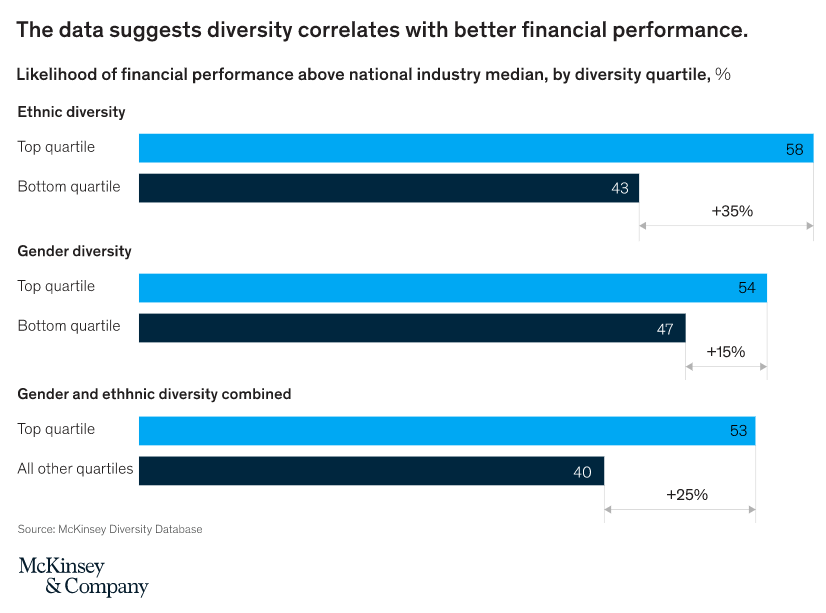
“The business case for diversity in the workplace is now overwhelming,” claims the World Economic Forum. Their article on the subject listed a collection of evidence that D&I has a direct positive impact on innovation and business performance. Research by The Hamilton Project proves that there is a direct correlation between high-skilled immigration and an increase in the level of innovation. “Increasing the share of college-educated immigrants in the population by one percentage point increases patents per capita by 6 percent. This impact is roughly twice as large for those with advanced degrees… A one percentage point–increase in the college-educated or advanced degree-holding immigrant shares of the U.S. population are estimated to produce a 12.3 percent or 27.0 percent increase in patenting per capita, respectively.”
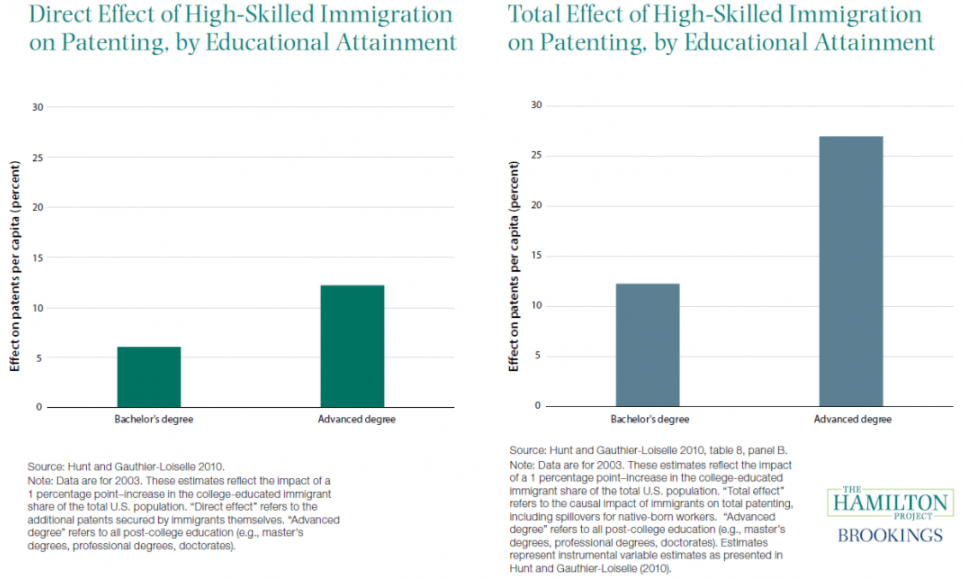
Catalyst, a global nonprofit whose mission is to build workplaces that work for women, found correlations between D&I and employee satisfaction benchmarks such as retention, productivity, decision-making, innovation, and team performance. There was also a link between diversity/inclusion and boosting company reputation, reducing instances of fraud, ESG performance, and financial performance. Here are some fast facts on their research:
- Companies with higher levels of gender diversity and with HR policies and practices that focus on gender diversity are linked to lower levels of employee turnover.
- Thirty-five percent of an employee’s emotional investment in their work and 20% of their desire to stay at their organization is linked to feelings of inclusion.
- According to one recent study, over a period of three years companies with higher diversity in management earned 38% more of their revenues, on average, from innovative products and services than those companies with lower diversity.
- Organizations with inclusive business cultures and practices are 57.8% more likely to improve their reputations.
- Companies with consistent, inclusive workplace cultures—especially as experienced by historically underrepresented groups—also outperformed the S&P 500 in average annual stock returns during the Great Recession (measured from 2006-2014).

Diversity and inclusion is important for innovation. It’s important for financial and employee performance. It even unwittingly impacts a company’s information security, recruiting efforts, and overall reputation. Not only does representation matter - if not properly implemented, it can cost a company actual dollars. The evidence is indeed overwhelming. There is no longer a question of if it will impact a company’s performance. It’s now a question of why, as in “why is this still happening?”
The Problem
It’s not for lack of trying. Companies have begun to recognize the issue and have implemented some misguided efforts toward D&I - such as intentionally hiring “diverse” individuals to try and tip back the scales. (Which is a problematic solution, to say the least.) Unfortunately, even with the best of intentions, companies must intentionally work toward diversity and inclusion if they ever want to see correct change.
Take for example “colorblindness.” This is the rhetoric that by not seeing someone’s race, they are not engaging with racial discrimination. In reality, not making note of someone’s race is inadvertently allowing people to ignore manifestations of discrimination in things like social, economic, and institutional practices. Being “colorblind” minimizes issues that people of color face. In a field experiment by the National Bureau of Economic Research, they found that identical resumes with white sounding names received 50% more callbacks for interviews than those with African American sounding names. Based on their estimates, a white name yields as many more callbacks as an additional 8 years of experience. They also found that federal contractors (who are thought to be more constrained by affirmative action laws) and employers who list “Equal Opportunity Employer” in their job ads discriminate just as much as other employers. It’s not enough to talk the talk.
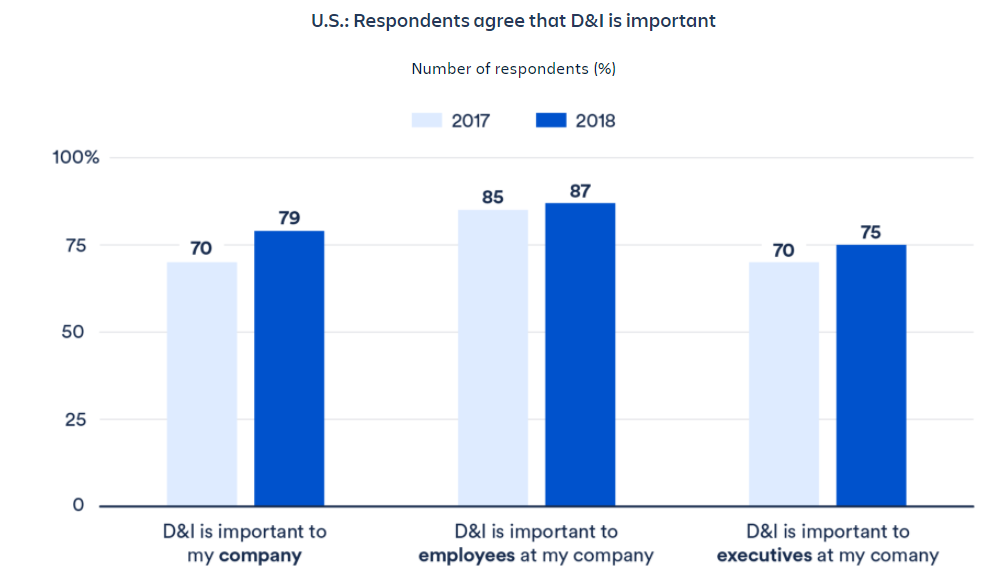
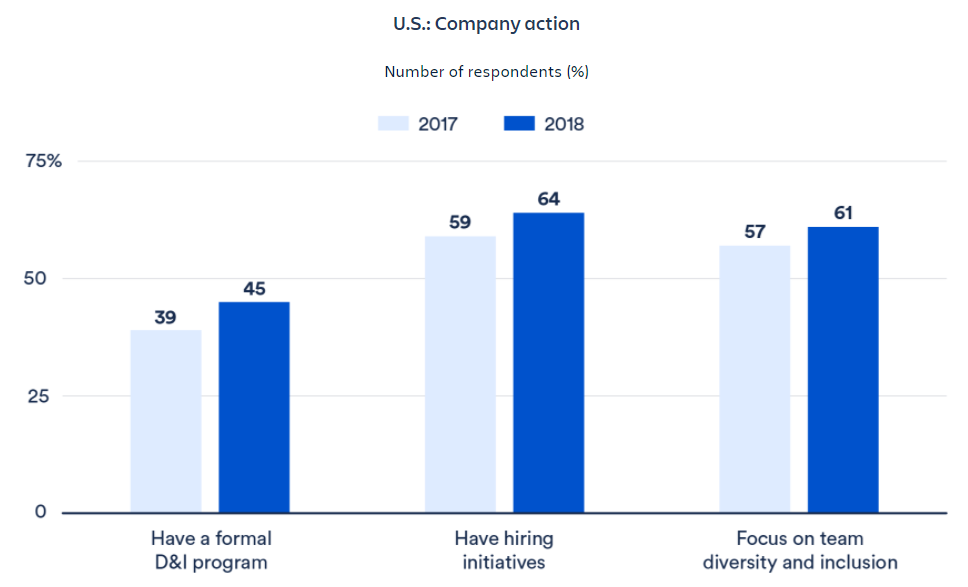
This also holds true for hiring, or not, based on the perception of “culture fit.” When hiring, it’s easy to be drawn to the person you most relate to within the interview process. Greenhouse, an HR organization that works to make every company great at hiring, wrote a blog unpacking unconscious bias while assessing candidates during the interview process. They state the definition of unconscious bias as “the accumulation of mental shortcuts both hardwired and developed, that lead us to form judgements, often unfair in nature.” You can learn more about unconscious bias, and how it impacts business in this LinkedIn Learning course. When looking to bring someone onto a team, people are prone to hire someone they would want to “have a beer with,” as the cherry on top of a good candidate. When given an equally qualified candidate, people tend to place unconscious bias against them - believing they are not as viable of a hire because they don’t fit this perception of “culture fit” in comparison to someone who does. Greenhouse suggests that instead of hiring based on “culture fit” that companies should strive for “culture add” - where the candidate would add to the existing culture, rather than mirror it.
If this is starting to sound like way too much work, you’re not alone. Diversity fatigue is real. Aubrey Blanche spoke about this idea while working as the Global Head of Diversity and Belonging at Atlassian. “The topic is everywhere and people are tired of talking about it. And much like compassion fatigue, caring hurts. You get frustrated by all this discussion not turning into meaningful action. It’s a fight that takes resources and energy, and it’s hard to stay committed when you’re barely seeing results,” says Blanche. Surely, everyone cares about diversity and inclusion - but few are willing to put in the hard work it takes to make a long term, impactful change. The issues are complex and can be emotional for many. But Blanche puts it best - “It’s not enough to just care about D&I. Without dedicating time and intention, you’re only reinforcing the pattern of mediocrity in the industry.”

In order to really tackle this issue, Blanche believes most companies are having the wrong conversation. Her company, Atlassin, published a report in 2018 about the State of Diversity and Inclusion in US Tech. This report discussed how, “most D&I programs focus on increasing the representation numbers of a narrowly-defined category of "diverse" candidates, instead of focusing on belonging and inclusion throughout the company.” In some cases, it might be that the reason a company is lacking in diversity is because they’re not putting enough effort into making their existing employees feel included.
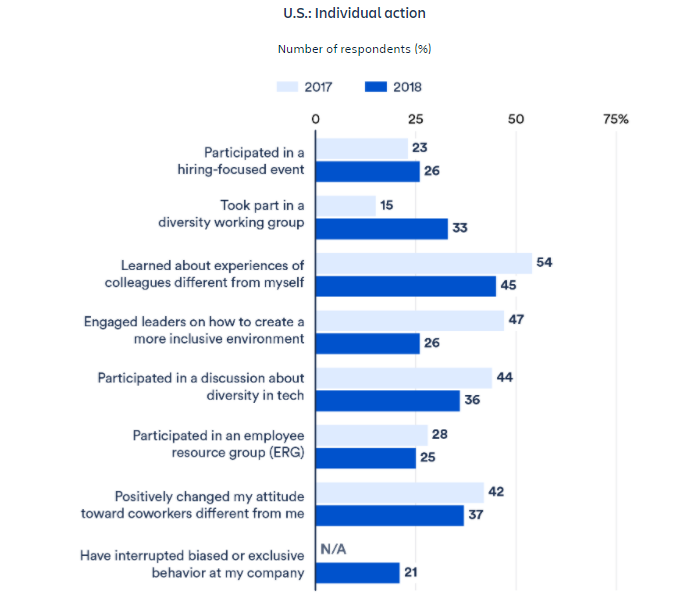
It’s not enough to look at these percentages and try to improve the statistics as if you’re only working with numbers and data. There are real people behind these stats, and sometimes that truth gets lost in translation when looking at the issue as a mountain to climb. Blanche expands, saying the “corporate level aggregate reports don’t actually measure diversity — they measure representation. It doesn’t matter if 30% of your company is made up of women if they’re all in marketing or HR and the men are in engineering.” If underrepresented groups are only found in certain job functions or are all only in particular teams, it doesn’t count. Diversity without distribution isn’t diversity at all.
The Solution
When looking at the problem as a whole, it can be very overwhelming. But when you look at its individual parts, you see that it’s the small actions that create the big picture. As hiring professionals, we are the gateway into an organization. It’s our job to establish that inclusivity from the start. To do this, we must become more comfortable with being uncomfortable. Greenhouse urges companies to approach diversity and inclusion with an open mind - these issues are complex, but by mentally reframing them as productive and an opportunity to learn, businesses will be able to make a change.
A great first step is to build and establish a D&I mission and brand. Rakuna developed a comprehensive checklist to help showcase an employer’s diversity brand - suggesting things like publishing a diversity statement from the CEO on the company’s career page. If you aren’t sure where to start with writing this, check out the US Chamber of Commerce’s blog on the topic. They say that a clear diversity, equity, and inclusion (DEI) strategy should contain what DEI means to you as an organization, why DEI matters to you, and how you will approach DEI - now and in the future.

But remember, we learned earlier that making the commitment on paper isn’t the same as taking action. By intentionally working against biases, we can start setting things in motion. And the first step in that process is to admit you have biases. The Digital Workplace says that “acknowledging the natural biases that you have openly with others can be a great way to disarm the situation rather than trying to skirt around the elephant in the room.” Outwardly admitting them makes these biases into something external you can work against. One excellent example of this is to establish blind screening policies. A study by Stanford University found that scientists were less likely to agree to mentor, offer jobs to, or recommend equal salaries for candidates based on the gender of their names at the top of identical resumes. By removing names, photos, and gendered pronouns in a resume - you can reduce the number of signals that could trigger gender bias. This isn’t perfect since you can still unconsciously create some bias based on past companies, geographic location, or even the college the person attended. A more foolproof method, that is widely popularized by developments in its technology, is to leverage artificial intelligence to automatically run initial screenings for you.
Taking the human element out of the hiring process can have this benefit - but as we are reminded by the fear of machines rising against man - it removes some of the more nuanced, human benefits as well. Companies can instead standardize how they review candidates by focusing on skills versus experiences. By writing out the specific qualities you’re actually looking for in a hire when writing job descriptions, rather than something vague like “bachelor’s degree in applicable field,” you can work to better target your actual needs. This could also result in a wider range of applicants in the funnel, helping you judge on potential rather than restrictive minimum requirements. Atlassin used this exact strategy and boosted their female technical hires by 80% in a year’s time.
Did you know that even the location you’re posting your jobs in can limit your diversity and inclusivity in the candidate pool? Tech companies in particular are known for being geographically concentrated in certain areas (Silicon Valley, for example). A whopping 75% of venture capital funding is concentrated in just three states! An interesting shift we are seeing with the developments of remote connectivity technology and the rise of the work-from-home norm is that geography is becoming less and less of a restriction on someone’s capability to work certain jobs. With this in mind, it’s hard to argue against hiring outside the usual locations. Harvard Business Review suggests that in order to increase diversity, companies should follow the talent. You can identify opportunities by looking at where people are graduating with the skills you need, or where there is a lower cost of living that could be more attractive to potential hires. Make your jobs more accessible to diverse groups by meeting the talent where it’s at.

Another hot button topic is pay equity. We can’t have the conversation about diversity and inclusion without mentioning it - especially since it’s seen across all industries. Companies need to push for pay equity not just for women, but for all intersectional groups. For instance, 2018 census data found that women of all races earn an average of 82 cents on the dollar compared to white men. But, this number is significantly lower for Hispanic or Latino women who make 54 cents on that same dollar. A person’s intersectionality can have a severely negative impact on their compensation when going unchecked. To turn this around, employers can start by being transparent with their compensation structure. First Round Review recommends gathering the market data yourself, and making it accessible to everyone in your company. This practice instills trust in your ranks, showing that you are looking out for their best interests by compensating them at fair, competitive rates. This starts the conversation where it’s most important - with employees. Then, once your current team is being paid equitably, you’ll be prepared to bring on new talent into that same pay structure. By including current employees at the forefront of your strategy, the end goal of D&I should fall in line as your organization grows.
Conclusion
Hiring is difficult in and of itself - even before considering the larger implications it can have within things like D&I. With a system so inadvertently stuck in a cycle that favors certain job seekers over others, there is still a lot to be learned before it can be equally beneficial for all. Working with professionals that specialize in representing candidates based on merit can help you on your journey to revamping your hiring practices to be more diverse and inclusive. Recruiting firms like Blue Signal work to connect companies with talent outside their network or who are otherwise inaccessible from the typical approach of posting a job and waiting for applicants. Better yet, we are constantly looking for ways to better incorporate D&I into hiring practices across the board.
At Blue Signal, we collaborate with businesses on overall strategy - helping with more than just identifying and securing top talent. We are experts on marketing opportunities. We can consult on equitable market rates for compensation; locations to find geographically diverse candidates; and retention tactics, to support all kinds of internal groups with their differing needs. We know how to attract more diverse candidates, and can help you improve your employer branding to reflect those D&I values. As Diversity and Inclusion (D&I) workplace advocates, we appreciate the diversity of our clients, candidates, and communities in which we live and do business. We take pride in recruiting the best talent based on qualifications and skill - without bias.
Whether you are just starting on the journey of implementing diversity and inclusion into your hiring strategy, or you have your goals set and just need some help to achieve them, Blue Signal is here to be your partner in the process. Contact us today to talk about your options, or leverage the resources below to move your organization in the right direction.
Resources
- 10 Steps to Kick Off your Strategic Recruitment - an article by Seed Capital, Denmark’s largest seed stage venture capital fund investing in tech companies.
- 12 Ways to Improve your Diversity Recruiting Strategy - and article by Recruitee, a talent acquisition software platform company.
- Diversity and Inclusion: 8 Best Practices for Changing your Culture - an article by CIO, an organization composed of several hundred of the world's leading chief information officers that work to share their collective expertise on business strategy, innovation, and leadership.
- How to Ensure Diversity in your Recruiting and Hiring Practices - an article by Evanto Tuts+, a leading publisher of online tutorials and courses for self-directed learners within a global community.
- National Diversity Council: A community based, national organization that champions diversity and inclusion across the country.
- Project Include: A non-profit that uses data and advocacy to accelerate diversity and inclusion solutions in the tech industry.
- Tidal Equality: an organization that helps business leaders learn more deeply about diversity, equality, and inclusion.
- Unconscious Bias - a LinkedIn Learning course that helps you learn what unconscious bias is, understand its importance, and identify it in order to begin thinking about bias in new terms.
